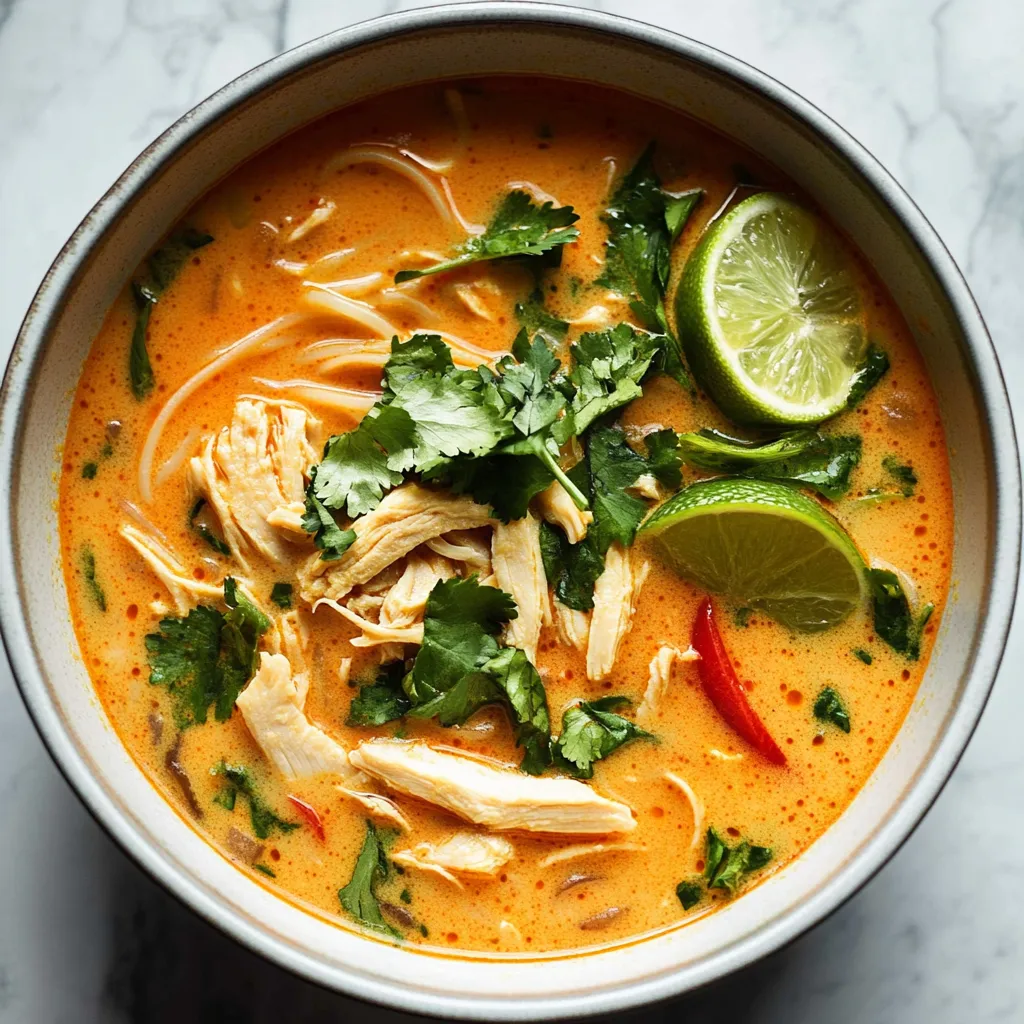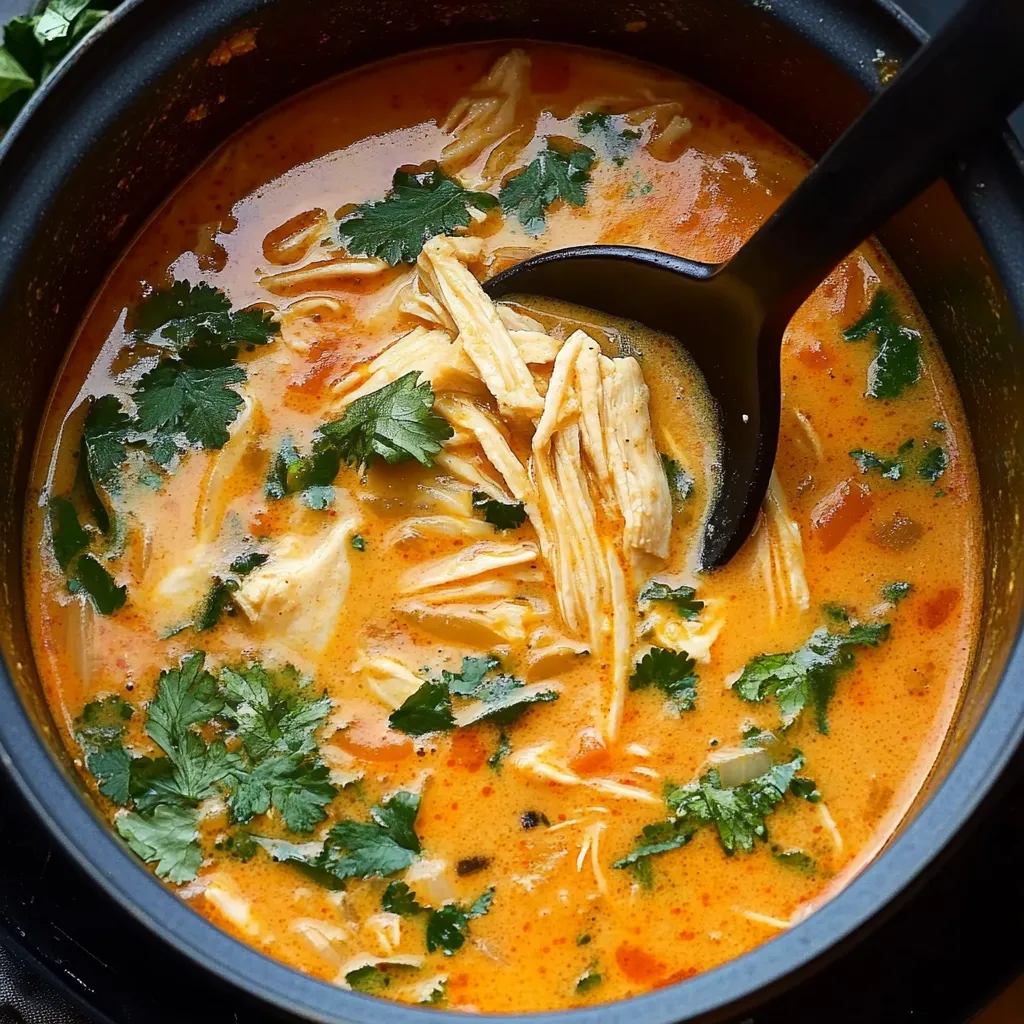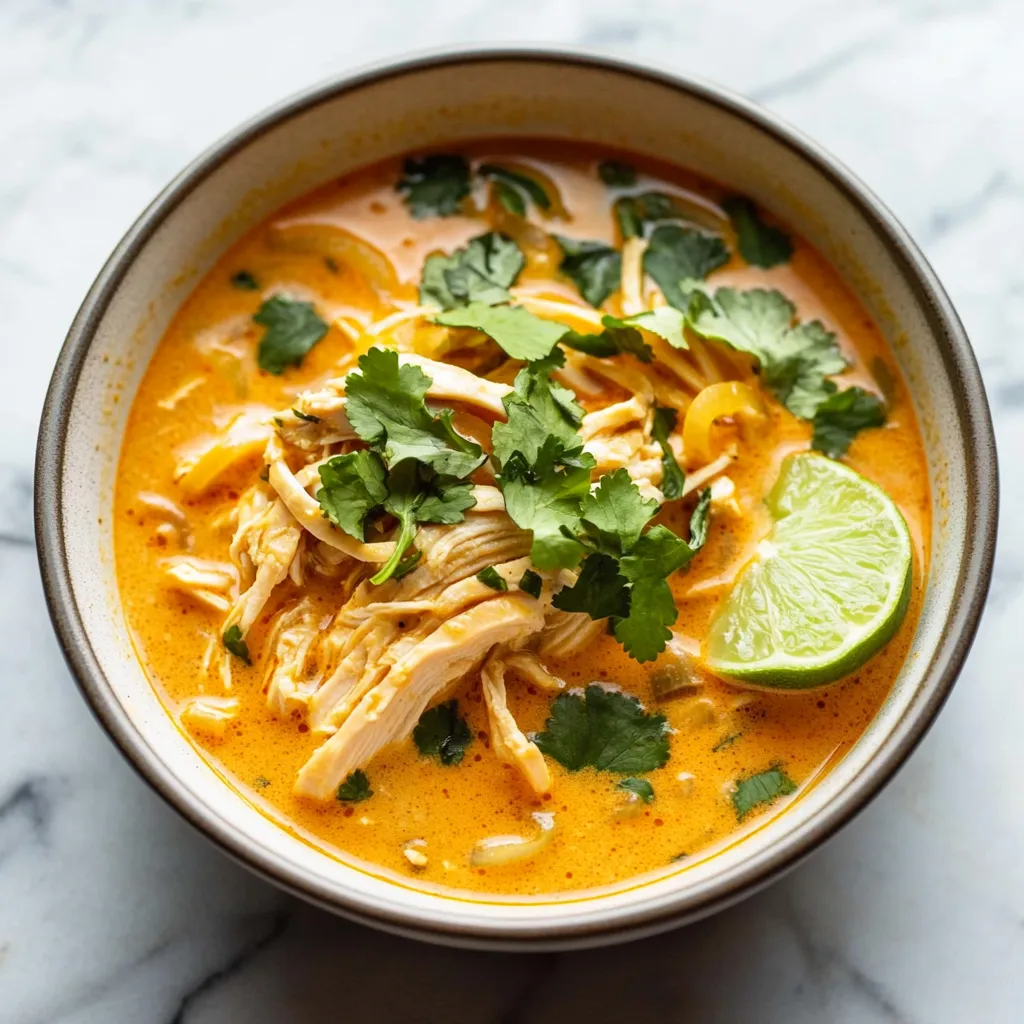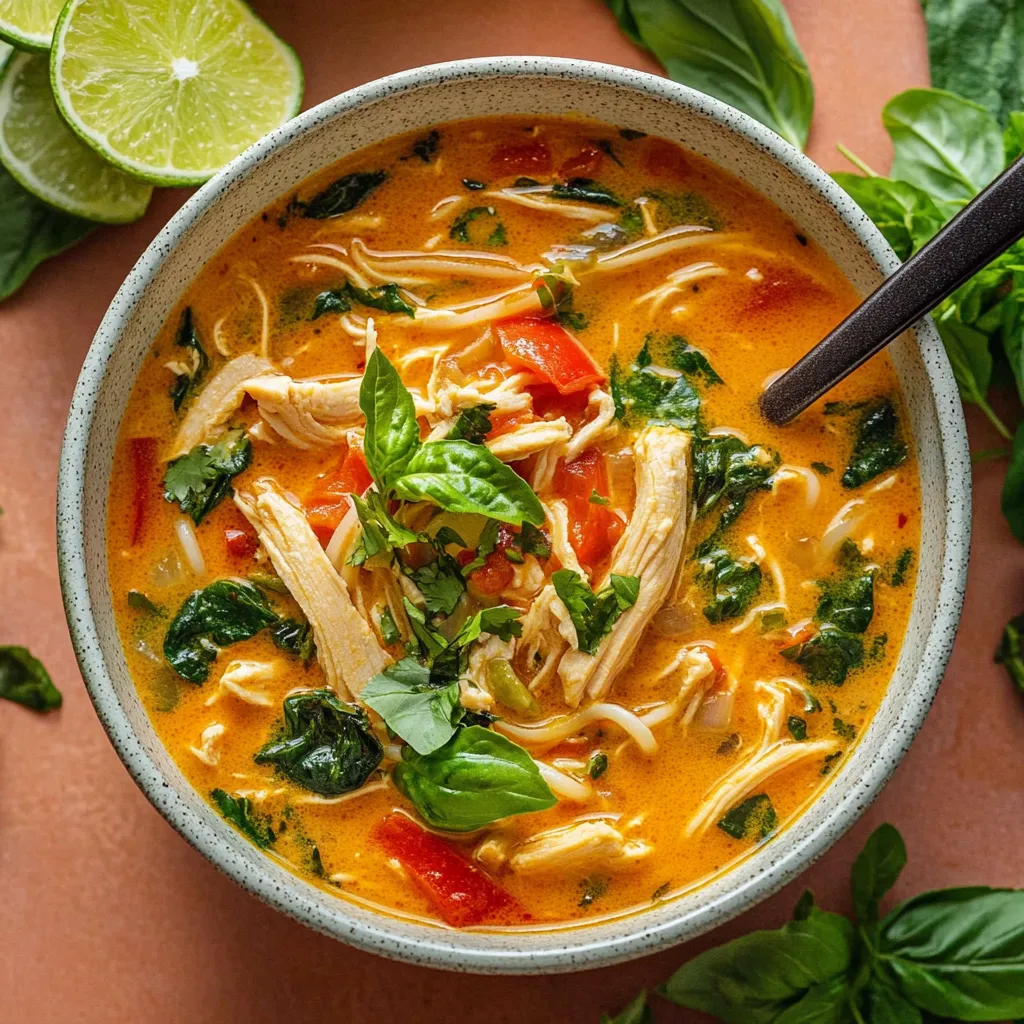 Pin it
Pin it
This vibrant Thai chicken curry soup delivers a perfect balance of creamy coconut milk, aromatic spices, and tender chicken that will transport your taste buds straight to Thailand. The harmony of red curry paste, fresh herbs, and tangy lime creates layers of flavor that build with each spoonful. Hearty enough for a main course yet light enough to enjoy year-round, this nourishing bowl combines authentic Thai flavors in an approachable one-pot recipe.
I've been making various versions of this soup for years, and it never fails to impress guests. Last winter, I served this to my neighbor who had just returned from Thailand, and she said it reminded her of the street food she enjoyed in Bangkok. The combination of fragrant herbs and rich coconut broth creates an experience that feels far more complex than the simple preparation suggests.
Essential Ingredients
- For the Aromatics Base:
- 2 tablespoons olive oil: Use a light olive oil that won't overpower the delicate Thai flavors
- 1 small yellow onion: Look for firm onions with tight, papery skin for best flavor
- 1 red bell pepper: Choose one that feels heavy for its size with bright, glossy skin
- 3 cloves garlic: Fresh cloves with tight, paper-like skin provide the strongest flavor
- 2 tablespoons fresh ginger: Select firm pieces with smooth skin for easy grating
- For the Soup Base:
- ¼ cup Thai red curry paste: Authentic brands like Mae Ploy or Maesri offer the truest flavor
- 8 cups chicken broth: Homemade provides the richest flavor, but quality store-bought works well
- 1 can (13.5 oz) full-fat coconut milk: Full-fat creates the silkiest texture and richest flavor
- 2 large chicken breasts: Look for plump, pink chicken with no discoloration
- For the Finish:
- 5 oz rice noodles: Thin rice vermicelli absorbs flavors beautifully without becoming mushy
- ½ cup fresh cilantro: Bright green bunches with no yellowing indicate freshness
- ½ cup fresh basil: Thai basil is ideal, but sweet basil makes a good substitute
- 3 oz baby spinach: Pre-washed varieties save time without sacrificing quality
- Juice of 1 lime: Choose heavy, fragrant limes with thin, smooth skin
 Pin it
Pin it
Detailed Cooking Instructions
- Step 1: Create Your Flavor Foundation
- Heat your Dutch oven over medium-high heat. Add the olive oil and allow it to warm until it shimmers but doesn't smoke. Add the diced yellow onion and thinly sliced red bell pepper. Sauté for 3-4 minutes, stirring occasionally, until the onions become translucent and the peppers start to soften. The aromatics should release their fragrance without browning.
- Step 2: Layer In The Aromatics
- Add the minced garlic and freshly grated ginger to the vegetable mixture. Stir continuously for about 60 seconds - this prevents burning while releasing their essential oils. Now add the red curry paste directly to the aromatics and stir vigorously. This crucial step "blooms" the spices, awakening their flavors and aromas. Continue cooking for another full minute until the paste darkens slightly and becomes intensely fragrant.
- Step 3: Build Your Soup Base
- Pour in the chicken broth gradually, about two cups at a time, whisking between additions to fully incorporate the curry paste. Next, add the coconut milk, stirring until completely blended with no visible streaks. Bring the mixture to a gentle simmer, not a rolling boil, to preserve the delicate flavors of the coconut milk.
- Step 4: Add Protein And Noodles
- Add your sliced or shredded chicken breast to the simmering broth. Next, add the rice noodles directly to the pot. Be sure to submerge them completely in the liquid. Increase the heat slightly to bring the soup back to a gentle boil, then immediately reduce to medium heat.
- Step 5: Perfect The Texture
- Allow the soup to simmer for 8-10 minutes, stirring occasionally to prevent the noodles from clumping together. The chicken should reach an internal temperature of 165°F, and the noodles should be tender but still have a slight bite. Be careful not to overcook or the noodles will become mushy.
- Step 6: Finish With Fresh Elements
- Reduce the heat to low, then add the fresh chopped cilantro, basil, and baby spinach. Stir gently until the spinach wilts, which should take about 1-2 minutes. The herbs will release their aromatic oils into the hot broth, creating another layer of flavor.
 Pin it
Pin it
My personal preference is for Mae Ploy curry paste, which I discovered during a cooking class in Chiang Mai. It has the perfect balance of chili heat and aromatic spices. When I make this soup for my family, I always add a bit more ginger than called for – it adds warmth and helps ward off winter colds.
The Cultural Heritage
This soup represents a beautiful fusion of traditional Thai flavors adapted for the western kitchen. Authentic Thai cooking balances the five fundamental flavors in every dish – the coconut milk provides sweetness, lime adds sourness, fish sauce contributes saltiness, curry paste delivers heat, and the chicken brings umami. Understanding this balance is key to creating truly satisfying Thai cuisine.
Mastering the Texture
One challenge with this soup is maintaining the perfect noodle texture. I've learned through trial and error that adding the noodles directly to the pot works best when serving immediately. If you plan to have leftovers, consider cooking the noodles separately and adding them to individual bowls when serving.
Creating Depth of Flavor
For an even more authentic taste, try substituting 1-2 tablespoons of fish sauce for an equal amount of the chicken broth. This adds that distinctive umami flavor that's characteristic of Thai cuisine. Start with a small amount – fish sauce is potent!
Vegetable Variations
This soup is incredibly adaptable. During summer months, I often add seasonal vegetables like zucchini or yellow squash. In autumn, butternut squash cubes make a delicious addition. The key is to add harder vegetables earlier in the cooking process and delicate ones toward the end.
 Pin it
Pin it
After years of experimenting with Thai cuisine, this soup has become my go-to comfort food during cold months. The beauty of this recipe lies in its adaptability – adjust the heat, swap proteins, or change the vegetables based on what you have available. What remains constant is the harmonious blend of flavors that makes Thai cuisine so beloved worldwide. Each spoonful offers a perfect balance of creamy, spicy, aromatic, and fresh elements that create a truly satisfying meal.
Frequently Asked Questions
- → Can I make this Thai chicken curry soup ahead of time?
- Yes! The flavors actually develop nicely overnight. Store in the refrigerator for up to 3 days, but add a bit more broth when reheating as it thickens while sitting.
- → Is this soup gluten-free?
- Yes, this soup is naturally gluten-free, just double-check your curry paste brand to ensure it doesn't contain any gluten ingredients.
- → Can I use a different protein instead of chicken?
- Absolutely! Shrimp works wonderfully, or tofu makes a great vegetarian option. Just adjust cooking times accordingly.
- → What can I substitute for fish sauce in the curry paste?
- If avoiding fish sauce in your curry paste, try using soy sauce with a squeeze of lime juice to get a similar salty, umami flavor.
- → Can I freeze this Thai chicken curry soup?
- Yes, but freeze it without the noodles and fresh herbs. Add these when reheating for the best texture and flavor.
